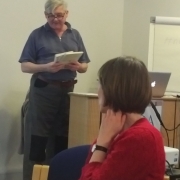January 2017 Seminar: Information Design: approaches to better communication
Summary
Conrad Taylor and Ruth Miller (long-standing practitioners of information design) presented some simple and practical applications of plain language, computer-based design, and design project management practices to help organisations and businesses to communicate clearly.
Conrad and Ruth looked at how information designers have developed approaches to clear communication (based on research by linguists, psychologists and other specialists). Whether information is written or visual, on paper or online, clear communication helps users find out what they need to know, to help them make informed decisions. Some simple workshop exercises helped promote discussion about ways to tackle everyday communication tasks and challenges.
The following summarizes the approach taken by Conrad and Ruth.
‘Official’ writing is often unclear (to say the least). Let’s assume that it isn’t a ploy to deceive us or hide the facts – rather, as George Orwell suggested, that ‘official’ writers may lack the skills to tell us plainly what we need to know. Concerns arise, nonetheless, when communications produced by organisations and businesses baffle publics and customers, or cause misunderstanding.
Sir Ernest Gowers addressed this problem in 1949 with his inspiring book Plain Words. But as a writer, he had little to say about how typography, visual arrangement and diagramming can help convey meaning, nor about how poor visual design can impair communication. Today, we have a range of devices and software available to help us both to edit text and to improve visual presentation, and they can be put to effective use with a little skill and knowhow.
‘Information design’ emerged as an interdisciplinary approach in the 1970s. It combines craft traditions in writing and design, applied psychology, and engineering methods such as prototyping and testing. Its effect can be seen in street and transport maps, computer interfaces, user guides, tax and business forms, legal documents, financial statements from banks and utilities, statistical graphs – and other types of communication.
Speakers
Conrad Taylor is a keynote speaker and conversational facilitator.
Conrad Taylor, for three decades a computer-based typographer and illustrator, and a trainer in communication design, has been involved with information design for 25 years. As well as empowering people with design knowledge and skills, he has helped organisations by designing suites of electronic stylesheets for document production. He writes on the interface between information management, technology, and design/publishing, and has an aspiration to gather up the stories of how these fields have developed over the last seven or eight decades. Conrad’s site Conradiator contains information on these and many related topics.
Ruth Miller hopped aboard the plain language bandwagon when it started rolling in a large government department in the 1980s. Her creative approach to clear communication has ‘uncomplicated’ much gobbledegook and thorny legal and financial documents in both public sector and agency environments. Most recently, she has applied plain language and simplification skills built up over many years of practice to teach English to refugees. Her mantra is, “clear writing stems from clear thinking”.
Time and Venue
2pm on 26th January 2017, The British Dental Association, 64 Wimpole Street, London W1G 8YS
Pre Event Information
• To understand the plain-language approach to written communication: the how and why (and successful outcomes)
• To learn how the design features of even simple computer software help us make print documents and web pages user-friendly
• To see design methods as problem-solving and best practice as a way to match business and communication objectives to audience needs
Slides
None
Tweets
Blog
See our blog report: Information Design
Study Suggestions
Sir Ernest Gowers book Plain Words

